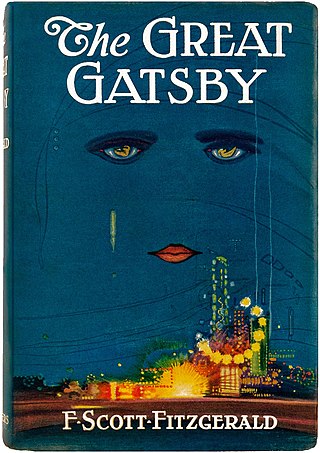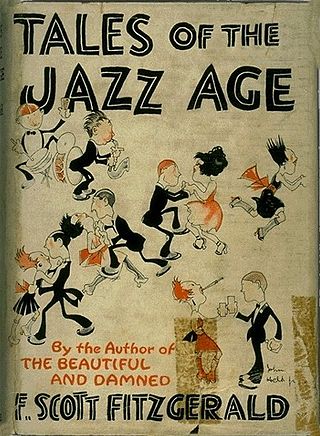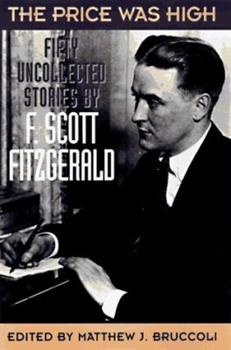Related Research Articles

Harry Sinclair Lewis was an American novelist, short-story writer, and playwright. In 1930, he became the first author from the United States to receive the Nobel Prize in Literature, which was awarded "for his vigorous and graphic art of description and his ability to create, with wit and humor, new types of characters." Lewis wrote six popular novels: Main Street (1920), Babbitt (1922), Arrowsmith (1925), Elmer Gantry (1927), Dodsworth (1929), and It Can't Happen Here (1935).

The Great Gatsby is a 1925 novel by American writer F. Scott Fitzgerald. Set in the Jazz Age on Long Island, near New York City, the novel depicts first-person narrator Nick Carraway's interactions with Jay Gatsby, the mysterious millionaire with an obsession to reunite with his former lover, Daisy Buchanan.
Edward Morley Callaghan was a Canadian novelist, short story writer, playwright, and TV and radio personality.

Zelda Fitzgerald was an American novelist, painter, and socialite. Born in Montgomery, Alabama, to a wealthy Southern family, she became locally famous for her beauty and high spirits. In 1920, she married writer F. Scott Fitzgerald after the popular success of his debut novel, This Side of Paradise. The novel catapulted the young couple into the public eye, and she became known in the national press as the first American flapper. Because of their wild antics and incessant partying, she and her husband became regarded in the newspapers as the enfants terribles of the Jazz Age. Alleged infidelity and bitter recriminations soon undermined their marriage. After Zelda traveled abroad to Europe, her mental health deteriorated, and she had suicidal and homicidal tendencies, which required psychiatric care. Her doctors diagnosed her with schizophrenia, although later posthumous diagnoses posit bipolar disorder.

The Saturday Evening Post is an American magazine, currently published six times a year. It was published weekly from 1897 until 1963, and then every other week until 1969. From the 1920s to the 1960s, it was one of the most widely circulated and influential magazines among the American middle class, with fiction, non-fiction, cartoons and features that reached two million homes every week.

The Short Stories of F. Scott Fitzgerald is a compilation of 43 short stories by F. Scott Fitzgerald. It was edited by Matthew J. Bruccoli and published by Charles Scribner's Sons in 1989. It begins with a foreword by Charles Scribner II and a preface written by Bruccoli, after which the stories follow in chronological order of publication.

"Bernice Bobs Her Hair" is a short story by F. Scott Fitzgerald. It was first published in May 1920 in The Saturday Evening Post. It was Fitzgerald's first short story to achieve national prominence. The original publication featured interior illustrations by May Wilson Preston. The work later appeared in the September 1920 short story collection Flappers and Philosophers published by Charles Scribner's Sons.

Flappers and Philosophers is a collection of eight short stories by American writer F. Scott Fitzgerald, published in 1920 by Charles Scribner's Sons. Each of the stories had originally appeared, independently, in either The Saturday Evening Post,Scribner's Magazine, or The Smart Set.

"Head and Shoulders" is a short story by F. Scott Fitzgerald. It was his first story to be published in the Saturday Evening Post, with the help of Fitzgerald's agent, Harold Ober. The story appeared in the February 21, 1920 issue and was illustrated by Charles D. Mitchell. It later appeared in his short story collection Flappers and Philosophers.

"The Ice Palace" is a modernist short story written by F. Scott Fitzgerald and published in The Saturday Evening Post on May 22, 1920. It is one of eight short stories originally published in Fitzgerald's first collection, Flappers and Philosophers, and is also included in the collection Babylon Revisited and Other Stories.

Tales of the Jazz Age (1922) is a collection of 11 short stories by American writer F. Scott Fitzgerald. Divided into three separate parts, it includes one of his better-known short stories, "The Curious Case of Benjamin Button". All of the stories had first appeared, independently, in either Metropolitan Magazine, The Saturday Evening Post, Smart Set, Collier's, the Chicago Sunday Tribune, or Vanity Fair.

Francis Scott Key Fitzgerald, widely known simply as Scott Fitzgerald, was an American novelist, essayist, and short story writer. He is best known for his novels depicting the flamboyance and excess of the Jazz Age, a term he popularized in his short story collection Tales of the Jazz Age. During his lifetime, he published four novels, four story collections, and 164 short stories. Although he achieved temporary popular success and fortune in the 1920s, Fitzgerald received critical acclaim only after his death and is now widely regarded as one of the greatest American writers of the 20th century.

All the Sad Young Men is a collection of short fiction by American writer F. Scott Fitzgerald. The stories originally appeared independently in popular literary journals and were first collected in February 1926 by Charles Scribner's Sons.

"The Offshore Pirate" is a short story written by F. Scott Fitzgerald in 1920. It is one of eight short stories included in Fitzgerald's first published collection, Flappers and Philosophers. The story was first published in the May 29, 1920 issue of The Saturday Evening Post and illustrated by Leslie L. Benson.

Taps at Reveille is a collection of 18 short stories by American writer F. Scott Fitzgerald, published by Charles Scribner's Sons in 1935. It was the fourth and final volume of previously uncollected short stories Fitzgerald published in his lifetime. The volume appeared a year after his novel Tender is the Night was published. The collection includes several stories featuring autobiographical creations derived from Fitzgerald's youth, namely Basil Duke Lee and Josephine Perry.
"The Freshest Boy" is a short story by American writer F. Scott Fitzgerald. It was first published in the July 28, 1928 issue of The Saturday Evening Post, and was reprinted in Fitzgerald's 1935 collection, Taps at Reveille.

The Basil and Josephine Stories is a collection of two separate short stories collections by F. Scott Fitzgerald which initially ran serially in The Saturday Evening Post. Some of them were later collected in Taps at Reveille and posthumous short story collections. The title characters were intended by Fitzgerald to meet each other, but this never happened in his literature. Basil Duke Lee, who was a fictionalized version of F. Scott Fitzgerald's younger self. Scott draws from his own experiences as a child and an adolescent.
"First Blood" is a short story by F. Scott Fitzgerald, originally published in the April 5, 1930 issue of The Saturday Evening Post, illustrated by Harry Russell Ballinger. It was later included in his 1935 short story collection Taps at Reveille.
"Absolution" is a short story by American writer F. Scott Fitzgerald. It was included in his 1926 collection All the Sad Young Men.

The Price Was High: Fifty Uncollected Stories by F. Scott Fitzgerald is a volume of short fiction by F. Scott Fitzgerald published by Harcourt Brace & Company in 1979.
References
- ↑ Fitzgerald, F. Scott (4 July 1931). "A New Leaf". The Saturday Evening Post . Archived from the original on 24 March 2014. Retrieved 24 March 2014.